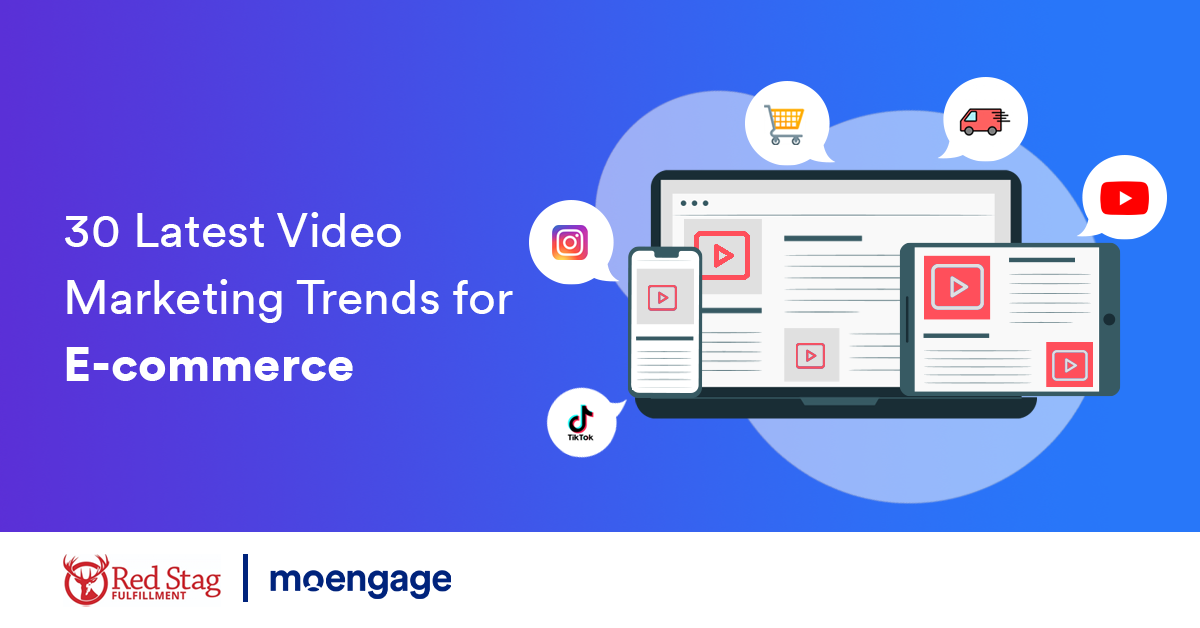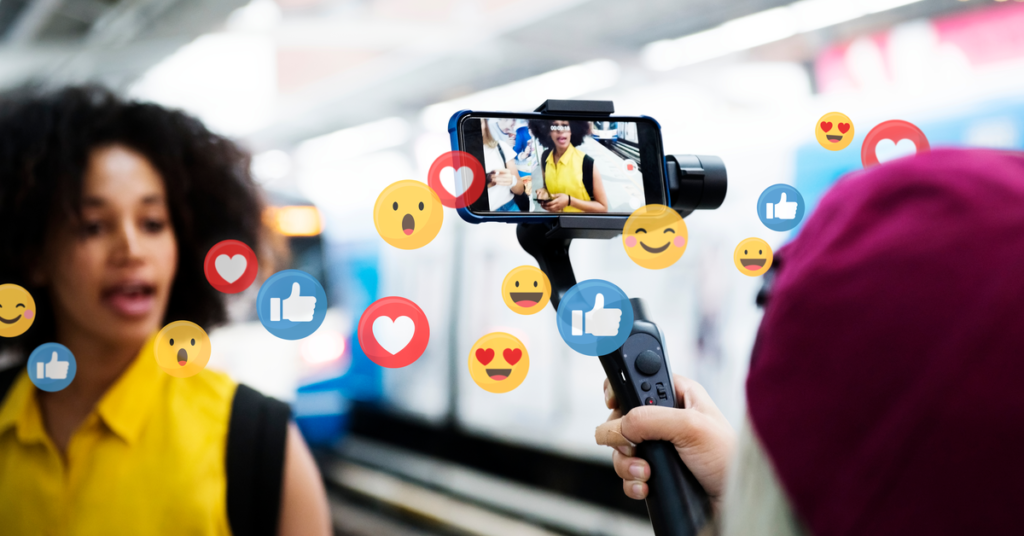30 Experts Share the Latest Video Marketing Trends for E-commerce

Reading Time: 12 minutes
As an e-commerce business, you need to stay on top of the latest video marketing trends. If you have been paying attention to the latest in content marketing, you’ll notice the video is where a lot of the most cutting-edge content is made. That’s in large part due to the skyrocketing popularity of TikTok and Instagram’s copycat Reels platform, both of which are and will continue to be pivotal to Customer Engagement now and beyond.
However content marketing and video marketing are broad and incredibly complex fields. To understand where video marketing for e-commerce businesses is headed, let’s hear from thirty different experts on what your business can do to stay on top of the latest trends.
1. Counterintuitive and Altruistic Video Content
Jeff Neal, the Engagement Officer for The Critter Depot, says:
Part of our marketing strategy is to grow our YouTube presence and build out tutorial videos on how to breed your own insects. At first glance, this is counterintuitive to our own business and profits – we’re showing viewers how to do what we do – but having an “altruistic” marketing strategy can yield incredible, viral results.
2. A Fresh Take On Drones

A video marketing trend to watch out for in 2021 is drone video. While aerial cinematography isn’t as popular as it was a few years ago, it’s still utilized regularly, and when done well, it’s a terrific method for your company to get the eye of potential clients. When drones were originally introduced, they were primarily employed to obtain high perspectives and present new views.
In 2021, drones are increasingly being used to highlight how all of the components of a story fit together in the larger picture by flying at lower angles and through scenes. Allowing viewers to see your business in this fresh light is fantastic and will give them a more authentic, first-person perspective.
– Jason McMahon, Digital Strategist at Bambrick
3. Real-Time Video Shopping
According to Tommy Gallagher, the Founder of Top Mobile Banks:
Real-time video shopping is a video marketing trend to watch out for in 2021. Real-time shopping is a blessing for millennials, a generation that suffers from a major fear of missing out (FOMO). Shoppable video content has limited availability currently, but we expect this to expand rapidly in the coming year. This will be a great way to reach younger audiences.
4. The Video Funnel
Video content will become a vital lead generator. Consumers are increasingly finding brands through video; 84% of shoppers have made a purchase decision after watching a brand’s video. After watching a video about software or an application, 80% of consumers went on to purchase it. Videos are becoming a bigger and more important part of the customer experience, particularly during the pandemic, with 96% of consumers reporting that they increased the amount of time they spend watching videos in the last year. Video content will become a major conversion tool in the coming years.
– Benjamin Aronson, Founder of FinancePond
5. 360-Degree Video
Adam Garcia, the Founder of The Stock Dork, says:
To effectively show off your product, try an immersive video style like 360-degree videos. This is one of the video trends that has changed the way that people watch content. It gives consumers control over how they perceive a product, and they can see a “demonstration” before deciding to purchase it.
6. User Generated Content
One aspect of video marketing that has seen a large rise over the last year, and is likely to become a marketing mainstay in 2022, is user-generated content. Customers who land on a site as a result of user-generated content stay on the site twice as long and are twice as likely to make a purchase. User content appears more organic and cuts through the usual marketing jargon and tactics that consumers have become wary of. We implement this strategy by encouraging our customers to post videos and photos of themselves unboxing, installing, and enjoying our products to their social media so that we can repost their content.
– Chris Campbell, CEO of The Charming Bench Company
7. Live Videos
As per Tanner Arnold, the President and CEO of Revelation Machinery:
By the end of 2021, the average person will have watched more than 16 hours of video per week. Live videos will be an incredibly effective way to reach out to potential clients. Because live videos are only available for 24 hours, it creates a sense of urgency that converts viewers. Users on Facebook spend three times as much time watching live content as they do watching uploaded videos, and today, every social media platform has a live video option that you can take advantage of.

8. Testimonial Videos
It may be surprising to learn that the biggest upward trend of video viewership in the last five years is in persons over the age of 45. This age group is more likely to rely on word-of-mouth recommendations when making a purchase, which makes video testimonials particularly effective. Furthermore, because such videos are honest and authentic, minimum editing is required, and you can generate this type of content even if you have little to no prior experience with video editing.
– Ben Rose, Co-founder and Personal Trainer at Trainer Academy
9. Homepage Videos
Diego Cardini, the Founder and Director of The Drum Ninja, says:
We consider homepage videos to be a virtual, interactive tool to give customers a taste of what the company has to offer. It’s almost like promoting your brand with a movie trailer. It’s a unique way to pique the audience’s interest in your brand, keep them on your site longer, and convert them into customers.
10. Authenticity Over Production Value
We’ve started to see a lot of success with more authentic videos. The days of overly produced content, especially on social media, seem to be coming to an end. To make an ad seem more organic, we’ve started to just use a smartphone and relatively unscripted lines to produce a video that looks like something anyone could post.
– Andrew Maff, Founder of BlueTuskr
11. Combining Digital and Out-Of-Home Advertising
Matt Weidle, the Business Development Manager at Buyer’s Guide, says:
Many of our clients were compelled to make a swift transition from traditional in-store marketing communications to digital marketing communications last year. Consumers quickly adapted to the change, and we’re approaching these initiatives a little differently this year. We’re working on combining in-person and digital messaging with campaigns that connect stories with digital and in-store deliverables.
12. User-Generated Content Informing Strategy
User-generated content is genuine, dependable, and entertaining! Furthermore, in a cluttered digital landscape, authentic material breaks through the clutter. This is also a goldmine, as you can use market research and reputation management in the form of social listening to succeed in the realm of user-generated content. Relevant material and dialogues found on social media sites, blogs, social networks, and forums can be used to inform customer engagement, collaboration, and new product creation through strategic governance.
– Jeroen VanGils, Managing Director at Lifi.co
13. Personalized Video Marketing
According to Peter Horne, the Content Lead at Geoff McDonald and Associates:
Video marketing is going to become a lot more personal in the near future. While video marketing in the past has been largely based on creativity and coming up with convincing ideas for content, the rise of influencer marketing has caused a shift. Consumers are finding value in marketing that shows the “real” side of the product. Things like product reviews from influencers, actual use case videos, etc. We are planning on incorporating more interactive means of video, like webinars and live videos, to help the content feel more personal and keep our audience engaged.
14. Live Video Streaming
When you consider that the average user has 51 apps loaded on their device, and video streaming applications account for more than 10% of that total, it’s clear that video content is the wave of the future. Live video streaming is undeniably one of the top video marketing trends for 2021, based on those figures alone.
– Bradley Bonnen, Founder and CEO of iFlooded
15. Humanized Live Content
As per Jon Torres, the Founder of Jon Torres and Brand Lovely:
Instagram Live, Reels, unfiltered content, and relatable influencers – these are all trending on Instagram right now. The common thread is that they work to make Instagram as close to real-time human interaction as possible, and that desire makes sense, given we are all social beings who have had to face unprecedented social limitations in recent months. So, while we hope for the pandemic to end soon, we’ll continue to see live, humanized video content do well.
This trend can be as simple as using a person’s voice for a voice-over instead of solely visual captioning. I prefer to post narrated videos (with subtitles) instead of just visual illustrations or photos that lack people. Another way to jump on this trend is to show unfiltered behind-the-scenes clips of your team hard at work on a current project.
16. Repurposing TikTok Videos

Trying to find your competitive edge in video content for 2022? TikTok is crushing the paid media space, and you would be missing the boat if you weren’t creating organic content, scheduling videos on TikTok, or testing TikTok ads for your brand. However, you’d also be missing the boat if you weren’t creating content that can be ported between TikTok, Reels, Facebook, and any other video marketing platform you’re on. Reuse, recycle, and repurpose your video assets to work smarter, not harder in 2022!
– Matthew Lally, Founder of TheGiftYak
17. Short-Form Content
Steven Holm, the Video Content Creator for Homegrounds, says:
One of the key factors for video marketing in 2022 will be short-form videos, as popularized by Tiktok, Instagram Reels, and now YouTube Shorts. 68% of people want to learn about a new product through short videos (Wyzowl, 2019). Explainer videos and tutorials also rank highly among viewers, with 84% of consumers buying a product after viewing an explainer video (HubSpot, 2021). Brands will also do well to factor in viral potential when seeking options for video marketing.
18. Short, Interactive, and Personalized
As video content becomes more popular across social media platforms, companies like mine are trying to get a piece of the pie. By 2022, we should see video content that is short, interactive, and personalized using AI. TikTok is a fantastic example of how bit-sized content is doing increasingly well with younger audiences, and I suspect more platforms will follow in their footsteps.
Interactive videos are relatable, shareable, and even trackable – so no matter your industry, it’s important to harness a high degree of interactivity in your video content. And lastly, advancements to AI have made it easier than ever for these tech giants to show the viewer personalized content that will keep them on their app, so companies should create content that fits nicely into smaller niches that young consumers are already watching.
– Laura Fuentes, Operator at Infinity Dish
19. Lack of Editing
According to Michael Russel, the Director of Digital Marketing at Ratchet Straps:
I strongly believe we are seeing a trend away from over-edited content to authentic videos with very little editing done (if at all) in short form. This breaks all the norms we’ve seen over the last decade or so, but there are countless examples of this trend happening. Milad from Subway is an account on TikTok that rapidly gained over 1.5 million subscribers simply by making his favorite subway sandwiches at work. His videos were barely edited and came across as genuine, and his channel exploded. I believe we’ll see a lot more stories like this one in the near future on every video-sharing platform.
20. Informative and Engaging Video Marketing
We love to use video to market our products. We’ve had a lot of success with informative video series and encouraging our customers to interact with our brand. For example, we had a lot of success with a series about our journey with Sichuanese food, from coming up with the idea and testing ingredients to combating negative stigmas about our culture’s food in America.
We also use our motto “Yes, you can put our sauce on anything” to encourage our customers to post their own content that we can interact with. It’s all about fun and creative ways to get consumers excited about your product and create some buzz around your company.
– Jing Gao, Founder and CEO of Fly by Jing
21. Challenge Your Viewers
William Schumacher, the CEO and Founder of Uprising Food, says:
We’ve had great success with video marketing for our business, and it’s a more “shareable” way to interact with customers. We share testimonials, podcast videos, recipes, and products, but our most successful series has been a “challenge” on our website that encourages customers to participate via posting a video on YouTube taking the “Toast Cleanse” challenge. We’ve been able to translate this challenge to our podcast as well. Creating an interactive challenge around user-generated video content has been a hugely successful strategy for us.
22. Embracing the Freedom of New Platforms

There is no status quo with TikTok (yet), and the platform allows for a great amount of versatility. Your content can be long or short, formal or informal, informative or just entertaining. TikTok is here to stay, and right now marketers have the opportunity to create whatever kind of video content they want! Also, in my opinion, Instagram Reels is just a place where TikTok creators repost their content for consumers without TikTok to see. TikTok should be the focus of your marketing efforts.
– Chloe Sisson, Outreach Coordinator at Zen Media
23. New Short-Form Content Opportunities
According to Daniel, the Owner of Tubefluence:
Throughout 2021, a lot of focus in the video marketing sphere has been put on short-form video content. TikTok has continued to gain popularity, and Instagram has gotten on the bandwagon with Reels. All signs point to this trend continuing in 2022.
The biggest what-if is related to YouTube Shorts, YouTube’s experiment with short-form content. I believe that YouTube has been testing the viability of Shorts throughout 2021 and is likely to release a standalone Shorts app. For e-commerce brands, this means that they should start testing short-form video ads and gathering data on existing platforms – and taking advantage of new ones, like Shorts, if they materialize.
24. Shoppable videos
Shoppable videos are currently being used in online ads, but I suspect we’ll see them become more common for influencers to use in subtle sponcon. The partnership formed last year between TikTok and Shopify to produce shoppable video content will definitely be a major contributing factor. Instead of simply being directed to an online store from an ad, it will likely become more integrated, like being able to purchase the clothing worn by the influencer in a dance video. It’ll be more fluid and give influencers a new way to monetize their content.
– Daivat Dholakia, Director of Operations at Force by Mojio
25. Pinterest
As per Laura Rike, a Pinterest Strategist:
Given that video content is one of the biggest marketing trends, I would tell entrepreneurs to not only use Pinterest but use it to its fullest capability, which includes video content. For example, the recently launched Idea Pins (Pinterest’s version of Reels or TikTok-style videos) can get a lot of eyes on your content and help build your credibility, visibility, email signups, and sales.

26. Caption or Bust
Viewers are increasingly watching videos without audio, particularly on mobile phones, as proven by a recent study that revealed that 85% of Facebook videos are watched without sound. As a result, marketers should prioritize creating videos that feature captions in order to appeal to this growing majority.
– Ted Liu, Founder and CEO of Just SEO
27. Rise of Niche Video Apps
Video streaming apps will gain even more control in 2022, but we’ll also see a move towards diversification. It’s predicted that by the end of 2021, the average U.S. consumer will have at least 9.5 streaming applications on their mobile phones (source). Until now, a lot of video marketing budget was spent on YouTube ads, which I believe will start to change. As the consumption of video through streaming platforms increases, marketers should consider switching to specific streaming apps that target their audience more specifically and direct more of their budget there.
– Casey Allen, CEO of Barista Warrior
28. Cross-Promotion
According to Ruben Gamez, the CEO of Docsketch:
There are so many platforms that exist for video marketing, and many more are yet to come. YouTube, Tiktok, Facebook, Instagram, and even LinkedIn represent the social media giants, but smaller platforms will continue to pop up as well. It will be impractical for any company to create separate videos for each platform, and they will find success in creating long-form content for one platform and repurposing it contextually to fit the other platforms they have a presence on.
29. Educational Marketing
Video marketing is becoming more “educational”. Audiences are seeking out videos that break down complex topics in detail, and marketers can find a great niche there. For our law firm, this is very beneficial because it means we have the opportunity to educate our audience and give them deeper insight into legal topics. The legal world is packed with information that can be useful to pretty much anyone, and we’ve had great success delivering strong video content that helps our audience make important decisions in their personal lives.
– Seth Price, Founding Partner of Price Benowitz LLP
30. Transformative Video
Videos that show transformation have wide appeal and great viral potential. Video has been great to increase engagement when we show our how-to videos, or simply a time-lapse of how one can put together a structure using our building kits from our website, so we prioritize making content around this topic. People really enjoy watching something unfold and transform because they can see how that can work for them as well.
– Travis McCain, VP of Marketing at General Steel Company
Conclusion
As shoppers continue to favor mobile e-commerce and engagement with their favorite brands via smartphone, there’s no end in sight to videos being a pivotal part of your marketing strategy. With so many new ways to make content more exciting and engaging than ever, your business should have no trouble inspiring and delighting customers.













